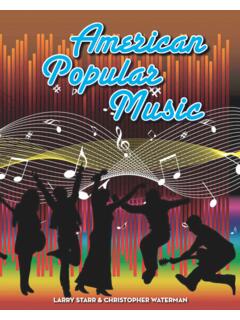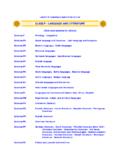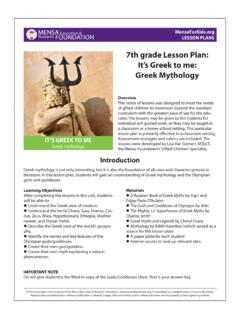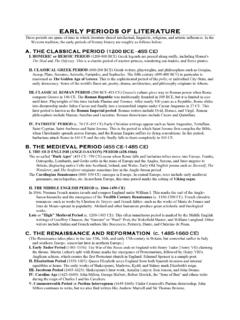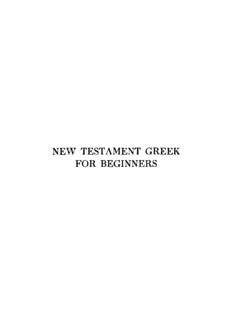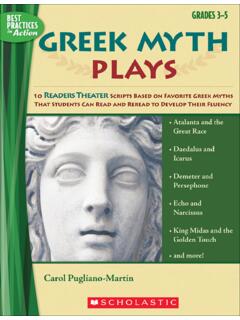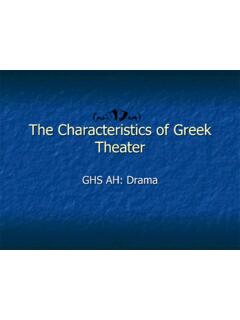Transcription of Outline of AMERICAN LITERATURE
1 AMERICANLITERATUREO utline of REVISED EDITION Early AMERICAN and colonial PEriod to 1776 dEmocratic origins and rEvolutionary WritErs, 1776-1820 thE romantic PEriod, 1820-1860: Essayists and PoEts thE romantic PEriod, 1820-1860: Fiction thE risE oF rEalism: 1860-1914 modErnism and ExPErimEntation: 1914-1945 AMERICAN PoEtry, 1945 1990: thE anti-tradition AMERICAN ProsE, 1945 1990: rEalism and ExPErimEntationcontEmPorary AMERICAN PoEtrycontEmPorary AMERICAN LITERATURE glossaryindExAMERICANLITERATURE314263647 607997121136157163 REVISED EDITIONP ublished by the united states dePartment of state staffWritten by: Kathryn VanSpancKerenexecutive editor: GeorGe clacKmanaging editor: paul MalaMudcontributing editor: Kathleen huGart director / designer: thaddeuS a.
2 MiKSinSKi, editor: Joann SternFront Cover: 1994 Christopher LittleABOUT THE AUTHORK athryn VanSpanckeren is Professor of English at the University of Tampa, has lectured in AMERICAN LITERATURE widely abroad, and is former director of the Fulbright-sponsored Summer Institute in AMERICAN LITERATURE for international scholars. Her publications include poetry and scholarship. She received her Bachelors degree from the University of California, Berkeley, and her from Harvard (paper) 978-1-625-92035-5 ISBN (ePub) 978-1-625-92036-2 ISBN (mobi) 978-1-625-92037-92 The following text materials may not be reproduced without permission of the copyright holder. In a Station of the Metro (page 63) by Ezra Pound. From Ezra Pound Personae. Copyright 1926 by Ezra Pound. Translated and reprinted by permission of New Directions Publishing Corporation.
3 Stopping by Woods on a Snowy Evening (page 65) by Robert Frost. From The Poetry of Robert Frost, edited by Edward Connery Lathem. Copyright 1923. 1969 by Henry Holt and Co., Inc., 1951 by Robert Frost. Reprinted and translated by permission of Henry Holt and Co., Inc. Disillusionment of Ten O Clock (page 66) by Wallace Stevens. From Selected Poems by Wallace Stevens. Copyright 1923 and renewed 1951 by Wallace Stevens. Reprinted by permis-sion of Alfred A. Knopf, Inc. The Red Wheelbarrow (page 66) and The Young Housewife (page 67) by William Carlos Williams. Collected Poems. 1909-1939. Vol. I. Copyright 1938 by New Directions Publishing Corp. Reprinted by permission of New Directions. The Negro Speaks of Rivers (page 69) by Langston Hughes. From Selected Poems by Langston Hughes.
4 Copyright 1926 by Alfred A. Knopf, Inc. and renewed 1954 by Langston Hughes. Reprinted by permission of the publisher. The Death of the Ball Turret Gunner (page 80) by Randall Jarrell from Randall Jarrell: Selected Poems; 1945 by Randall Jarrell, 1990 by Mary Von Schrader Jarrell, published by Farrar Straus & Giroux. Permission granted by Rhoda Weyr Agency, New York. The Wild Iris (page 125) from The Wild Iris by Louise Gl ck. Copyright 1993 by Louise Gl ck. Reprinted by permission of HarperCollins Publishers Inc. Chickamauga (page 126) from Chickamauga by Charles Wright. Copyright 1995 by Charles Wright. Reprinted by permission of Farrar, Straus and Giroux, LLC. To The Engraver of my Skin (page 129) from Source by Mark Doty. Copyright 2001 by Mark Doty. Reprinted by permission of HarperCollins Publishers Inc.
5 Mule Heart (page 130) from The Lives of The Heart by Jane Hirshfield. Copyright 1997 by Jane Hirshfield. Reprinted by permission of HarperCollins Publishers Inc. The Black Snake (page 131) copyright 1979 by Mary Oliver. Used with permission of the Molly Malone Cook Literary Agency. The Dead (page 132) is from Questions About Angels by Billy Collins, 1991. Reprinted by permission of the University of Pittsburgh Press. The Want Bone (page 133) from The Want Bone by Robert Pinsky. Copyright 1991 by Robert Pinsky. Reprinted by permission of HarperCollins Publishers Inc. Yusef Komunyakaa, Facing It (page 134) from Dien Cai Dau in Pleasure Dome: New and Collected Poems, 2001 by Yusef Komunyakaa and reprinted by permission of Wesleyan University Press. A number of the illustrations appearing in this volume are also copyrighted, as is indicated on the illustrations themselves.
6 These may not be reprinted without the permission of the copyright opinions expressed in this publication do not necessarily reflect the views or policies of the AMERICAN and colonial PEriod to 1776 AMERICAN LITERATURE begins with the orally transmitted myths, legends, tales, and lyrics (always songs) of Indian cultures. There was no written LITERATURE among the more than 500 different Indian languages and tribal cultures that existed in North America before the first Europeans arrived. As a result, Native AMERICAN oral LITERATURE is quite diverse. Narratives from quasi-nomadic hunting cul-tures like the Navaho are different from stories of settled agricultural tribes such as the pueblo-dwelling Acoma; the stories of northern lakeside dwellers such as the Ojibwa often differ radically from stories of desert tribes like the maintained their own religions worshipping gods, animals, plants, or sacred persons.
7 Systems of government ranged from democracies to councils of elders to theocra-cies. These tribal variations enter into the oral LITERATURE as , it is possible to make a few generaliza-tions. Indian stories, for example, glow with reverence for nature as a spiritual as well as physical mother. Nature is alive and endowed with spiritual forces; main characters may be animals or plants, often totems associated with a tribe, group, or individual. The closest to the Indian sense of holiness in later AMERICAN LITERATURE is Ralph Waldo Emerson s transcen-dental Over-Soul, which pervades all of Mexican tribes revered the divine Quet-zalcoatl, a god of the Toltecs and Aztecs, and some tales of a high god or culture were told elsewhere. However, there are no long, stan-dardized religious cycles about one supreme divinity.
8 The closest equivalents to Old World spiritual narratives are often accounts of shamans initiations and voyages. Apart from these, there are stories about culture heroes such as the Ojibwa tribe s Manabozho or the Navajo tribe s Coyote. These tricksters are treated with varying degrees of respect. In one tale they may act like heroes, while in another they may seem selfish or foolish. Although past authorities, such as the Swiss psycholo-gist Carl Jung, have deprecated trickster tales as expressing the inferior, amoral side of the psyche, contemporary scholars some of them Native Americans point out that Odysseus and Prometheus, the revered greek heroes, are essentially tricksters as of almost every oral genre can be found in AMERICAN Indian LITERATURE : lyrics, chants, myths, fairy tales, humorous anec-dotes, incantations, riddles, proverbs, epics, and legendary histories.
9 Accounts of migra-tions and ancestors abound, as do vision or healing songs and tricksters tales. Certain creation stories are particularly popular. In one well-known creation story, told with variations among many tribes, a turtle holds up the world. In a Cheyenne version, the creator, Maheo, has four chances to fashion the world from a watery universe. He sends four water birds diving to try to bring up earth from the bottom. The snow goose, loon, and mallard soar high into the sky and sweep down in a dive, but cannot reach bottom; but the little coot, who cannot fly, succeeds in bringing up some mud in his bill. Only one creature, humble Grandmother Turtle, is the right shape to support the mud world Maheo shapes on her shell hence the Indian name for America, Turtle Island.
10 The songs or poetry, like the narratives, range from the sacred to the light and humor-ous: There are lullabies, war chants, love songs, and special songs for children s games, 3 chaPtEr 1gambling, various chores, magic, or dance cer-emonials. Generally the songs are repetitive. Short poem-songs given in dreams sometimes have the clear imagery and subtle mood asso-ciated with Japanese haiku or Eastern-influ-enced imagistic poetry. A Chippewa song runs:A loon I thought it wasBut it wasMy love ssplashing songs, often very short, are anoth-er distinctive form. Appearing in dreams or visions, sometimes with no warning, they may be healing, hunting, or love songs. Often they are personal, as in this Modoc song:Ithe songI walk oral tradition and its relation to AMERICAN LITERATURE as a whole is one of the richest and least explored topics in AMERICAN studies.

